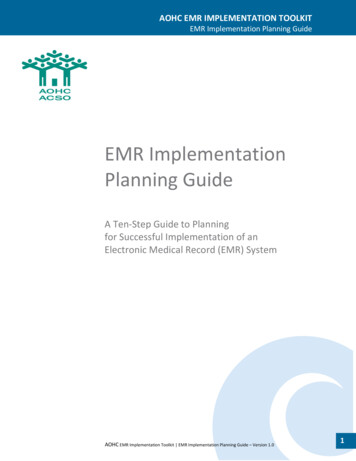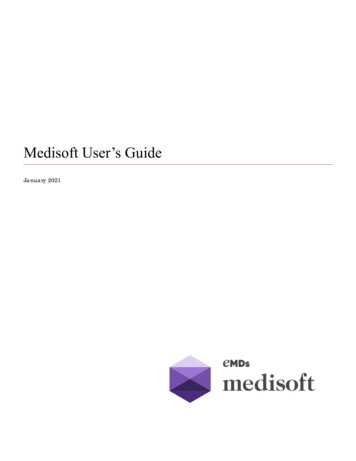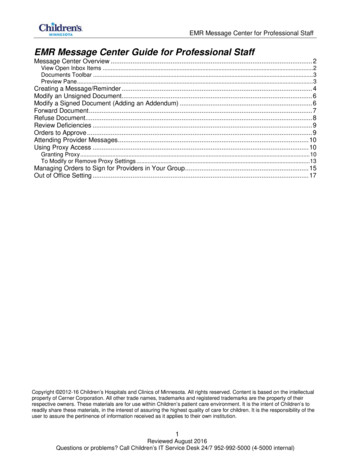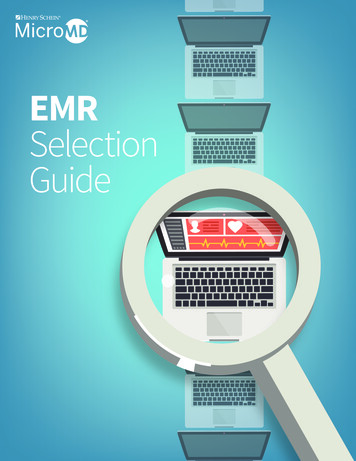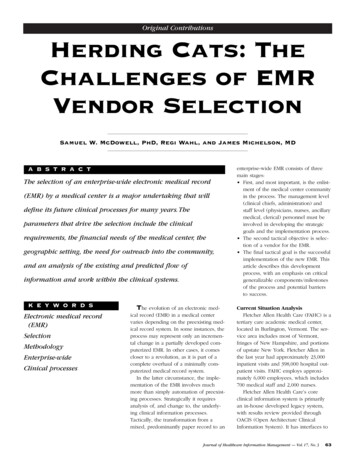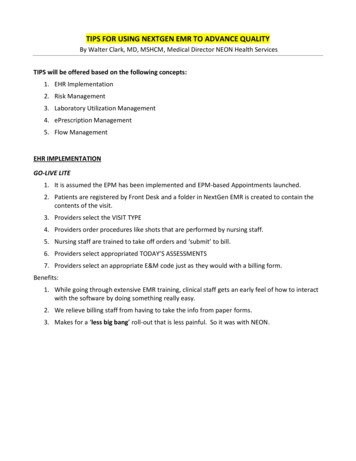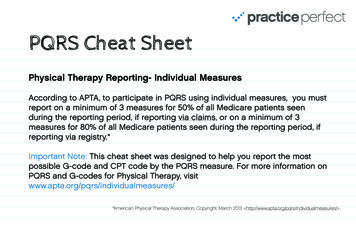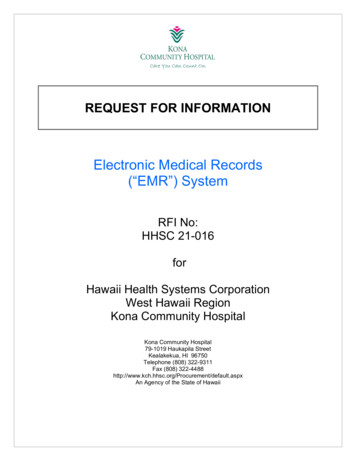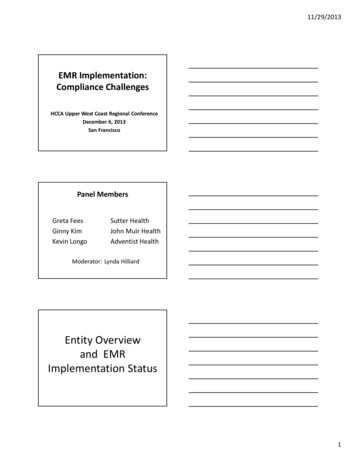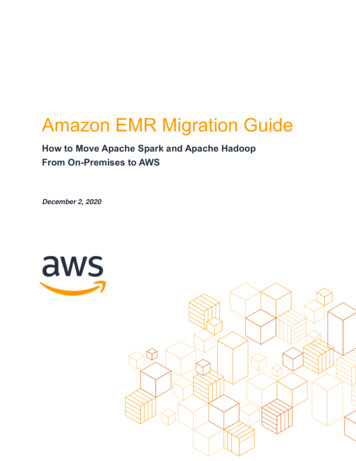
Transcription
Amazon EMR Migration GuideHow to Move Apache Spark and Apache HadoopFrom On-Premises to AWSDecember 2, 2020
NoticesCustomers are responsible for making their own independent assessment of theinformation in this document. This document: (a) is for informational purposes only, (b)represents current AWS product offerings and practices, which are subject to changewithout notice, and (c) does not create any commitments or assurances from AWS andits affiliates, suppliers or licensors. AWS products or services are provided “as is”without warranties, representations, or conditions of any kind, whether express orimplied. The responsibilities and liabilities of AWS to its customers are controlled byAWS agreements, and this document is not part of, nor does it modify, any agreementbetween AWS and its customers. 2020 Amazon Web Services, Inc. or its affiliates. All rights reserved.
ContentsOverview .1Starting Your Journey .3Migration Approaches .3Prototyping .6Choosing a Team .8General Best Practices for Migration .9Gathering Requirements .11Obtaining On-Premises Metrics .11Cost Estimation and Optimization .12Optimizing Costs .12Storage Optimization.13Compute Optimization.16Cost Estimation Summary .19Optimizing Apache Hadoop YARN-based Applications.19Amazon EMR Cluster Segmentation Schemes .22Cluster Characteristics .22Common Cluster Segmentation Schemes .24Additional Considerations for Segmentation .25Securing your Resources on Amazon EMR .26EMR Security Best Practices .26Authentication .27Authorization.31Encryption.41Perimeter Security .44Network Security .45Auditing .47
Software Patching .48Software Upgrades .49Common Customer Use Cases .50Data Migration .55Using Amazon S3 as the Central Data Repository .55Large Quantities of Data on an Ongoing Basis .58Event and Streaming Data on a Continuous Basis .62Optimizing an Amazon S3-Based Central Data Repository .63Optimizing Cost and Performance .66Data Catalog Migration.70Hive Metastore Deployment Patterns .70Hive Metastore Migration Options .75Multitenancy on EMR .78Silo Mode .78Shared Mode .80Considerations for Implementing Multitenancy on Amazon EMR .81Extract, Transform, Load (ETL) on Amazon EMR.88Orchestration on Amazon EMR .88Migrating Apache Spark .98Migrating Apache Hive .102Amazon EMR Notebooks.108Incremental Data Processing .112Considerations for using Apache Hudi on Amazon EMR .113Sample Architecture .118Providing Ad Hoc Query Capabilities .120Considerations for Presto .120HBase Workloads on Amazon EMR.122Migrating Apache Impala .127
Operational Excellence .128Upgrading Amazon EMR Versions .128General Best Practices for Operational Excellence .132Testing and Validation .133Data Quality Overview .133Check your Ingestion Pipeline .134Overall Data Quality Policy .135Estimating Impact of Data Quality .136Tools to Help with Data Quality .138Amazon EMR on AWS Outposts .139Limitations and Considerations.139Support for Your Migration .141Amazon EMR Migration Program .141AWS Professional Services .142AWS Partners .144AWS Support .144Contributors .146Additional Resources .147Document Revisions.148Appendix A: Questionnaire for Requirements Gathering .149Security Requirements .151TCO Considerations.151Appendix B: EMR Kerberos Workflow .152EMR Kerberos Cluster Startup Flow for KDC with One-Way Trust.152EMR Kerberos Flow Through Hue Access.153EMR Kerberos Flow for Directly Interacting with HiveServer2 .154EMR Kerberos Cluster Startup Flow .155Appendix C: Sample LDAP Configurations .157
Example LDAP Configuration for Hadoop Group Mapping .157Example LDAP Configuration for Hue .157Appendix D: Data Catalog Migration FAQs .159
About this GuideFor many customers, migrating to Amazon EMR raises many questions aboutassessment, planning, architectural choices, and how to meet the many requirements ofmoving analytics applications like Apache Spark and Apache Hadoop from on-premisesdata centers to a new AWS Cloud environment. Many customers have concerns aboutthe viability of distribution vendors or a purely open-source software approach, and theyneed practical advice about making a change. This guide includes the overall steps ofmigration and provides best practices that we have accumulated to help customers withtheir migration journey.
Amazon Web ServicesAmazon EMR Migration GuideOverviewBusinesses worldwide are discovering the power of new big data processing andanalytics frameworks like Apache Hadoop and Apache Spark, but they are alsodiscovering some of the challenges of operating these technologies in on-premises datalake environments. Not least, many customers need a safe long-term choice of platformas the big data industry is rapidly changing and some vendors are now struggling.Common problems include a lack of agility, excessive costs, and administrativeheadaches, as IT organizations wrestle with the effort of provisioning resources,handling uneven workloads at large scale, and keeping up with the pace of rapidlychanging, community-driven, open-source software innovation. Many big data initiativessuffer from the delay and burden of evaluating, selecting, purchasing, receiving,deploying, integrating, provisioning, patching, maintaining, upgrading, and supportingthe underlying hardware and software infrastructure.A subtler, if equally critical, problem is the way companies’ data center deployments ofApache Hadoop and Apache Spark directly tie together the compute and storageresources in the same servers, creating an inflexible model where they must scale inlock step. This means that almost any on-premises environment pays for high amountsof under-used disk capacity, processing power, or system memory, as each workloadhas different requirements for these components.How can smart businesses find success with their big data initiatives?Migrating big data (and machine learning) to the cloud offers many advantages. Cloudinfrastructure service providers, such as Amazon Web Services (AWS), offer a broadchoice of on-demand and elastic compute resources, resilient and inexpensivepersistent storage, and managed services that provide up-to-date, familiar environmentsto develop and operate big data applications. Data engineers, developers, datascientists, and IT personnel can focus their efforts on preparing data and extractingvaluable insights.Services like Amazon EMR, AWS Glue, and Amazon S3 enable you to decouple andscale your compute and storage independently, while providing an integrated, wellmanaged, highly resilient environment, immediately reducing so many of the problemsof on-premises approaches. This approach leads to faster, more agile, easier to use,and more cost-efficient big data and data lake initiatives.1
Amazon Web ServicesAmazon EMR Migration GuideHowever, the conventional wisdom of traditional on-premises Apache Hadoop andApache Spark isn’t always the best strategy in cloud-based deployments. A simple liftand shift approach to running cluster nodes in the cloud is conceptually easy butsuboptimal in practice. Different design decisions go a long way towards maximizingyour gains as you migrate big data to a cloud architecture.This guide provides the best practices for: Migrating data, applications, and catalogs Using persistent and transient resources Configuring security policies, access controls, and audit logs Estimating and minimizing costs, while maximizing value Leveraging the AWS Cloud for high availability (HA) and disaster recovery (DR) Automating common administrative tasksAlthough not intended as a replacement for professional services, this guide covers awide range of common questions, and scenarios as you migrate your big data and datalake initiatives to the cloud.2
Amazon Web ServicesAmazon EMR Migration GuideStarting Your JourneyMigration ApproachesWhen starting your journey for migrating your big data platform to the cloud, you mustfirst decide how to approach migration. One approach is to re-architect your platform tomaximize the benefits of the cloud. The other approach is known as lift and shift, is totake your existing architecture and complete a straight migration to the cloud. A finaloption is a hybrid approach, where you blend a lift and shift with re-architecture. Thisdecision is not straightforward as there are advantages and disadvantages of bothapproaches.A lift and shift approach is usually simpler with less ambiguity and risk. Additionally, thisapproach is better when you are working against tight deadlines, such as when yourlease is expiring for a data center. However, the disadvantage to a lift and shift is that itis not always the most cost effective, and the existing architecture may not readily mapto a solution in the cloud.A re-architecture unlocks many advantages, including optimization of costs andefficiencies. With re-architecture, you move to the latest and greatest software, havebetter integration with native cloud tools, and lower operational burden by leveragingnative cloud products and services.This paper provides advantages and disadvantages of each migration approach fromthe perspective of the Apache Hadoop ecosystem. For a general resource on decidingwhich approach is ideal for your workflow, see An E-Book of Cloud Best Practices forYour Enterprise, which outlines the best practices for performing migrations to the cloudat a higher level.Re-ArchitectingRe-architecting is ideal when you want to maximize the benefits of moving to the cloud.Re-architecting requires research, planning, experimentation, education,implementation, and deployment. These efforts cost resources and time but generallyprovide the greatest rate of return as reduced hardware and storage costs, operationalmaintenance, and most flexibility to meet future business needs.3
Amazon Web ServicesAmazon EMR Migration GuideA re-architecture approach to migration includes the following benefits for yourapplications: Independent scaling of components due to separated storage and computeresources. Increased productivity and lowered costs by leveraging the latest features andsoftware. Ability to prototype and experiment quickly due to provisioning resourcesquickly. Options to scale system vertically (by requesting more powerful hardware) andhorizontally (by requesting more hardware units). Lowered operational burden by no longer managing many aspects of clusterlifecycle, including replacing failed nodes, upgrades, patching, etc. Sinceclusters can be treated as transient resources, they can be decommissionedand restarted. Data accessibility when using a data lake architecture, data is stored on acentral storage system that can be used by a wide variety of services and toolsto ingest and process the data for different use cases. For example, usingservices such as AWS Glue, and Amazon Athena and other services cangreatly reduce operational burden and reduce costs, and can only be leveragedif data is stored on S3. Ability to treat compute instances as transient resources, and only use as muchas you need, when you actively need it.Best Practices for Re-architectingWhen re-architecting your system for the use of Amazon EMR, consider the followingbest practices: Read the documentation found in this guide for reference architectures andapproaches that others have taken to successfully migrate. Reach out to an AWS representative early for a roadmap on architectures thatwould meet your use case and goals.Lift and ShiftThe lift and shift approach is the ideal way of moving workloads from on-premises to thecloud when time is critical and ambiguity is high. Lift and shift is the process of moving4
Amazon Web ServicesAmazon EMR Migration Guideyour existing applications from one infrastructure to another. The benefits to thisapproach are: Fewer number of changes. Since the goal is to move applications toenvironments that are similar to the existing environment, changes are limitedto only those required to make the application to work on the cloud. Less risk because fewer changes reduce the unknowns and unexpected work. Shorter time to market because fewer number of changes reduces the amountof training needed by engineers.Best Practices for Lift and Shift Consider using Amazon S3 for your storage instead of HDFS because thisapproach reduces costs significantly, and it allows you to scale compute to theamount of data. When using HDFS, the data must be replicated by at least twotimes, requiring more storage. The main cost driver is the cost of storage bystoring the data on EC2 instances using expensive disk-based instances orusing large EBS volumes. A quick calculation using AWS cost calculator showsthat storage costs for HDFS can be up to three times the cost of Amazon S3.See Using Amazon S3 as the Central Data R
About this Guide For many customers, migrating to Amazon EMR raises many questions about assessment, planning, architectural choices, and how to meet the many requirements of

